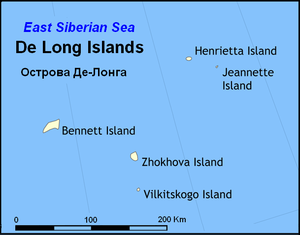Shokhov Island
| Shokhov Island | |
|---|---|
| Waters | East Siberian Sea |
| Archipelago | De Long Islands |
| Geographical location | 76 ° 9 ' N , 152 ° 43' E |
| length | 10.8 km |
| width | 8.7 km |
| surface | 77 km² |
| Highest elevation | 123 m |
| Residents | uninhabited |
| Map of the De Long Islands, with Shokhov Island (Zhokova) in the center | |
The Schochow Island ( Russian Остров Жохова , Ostrow Schochowa ) is an island in the East Siberian Sea , a part of the Arctic Ocean . It belongs geographically to the group of De Long Islands , part of the New Siberian Islands , administratively to the Russian Republic of Sakha (Yakutia).
geography
The Shokhov Island is located about 600 kilometers north of the north coast of Siberia and 128 kilometers northeast of the island of New Siberia . Its area is 77 km², its highest point is 123 meters above sea level. Even in summer the island is surrounded by pack ice , but not glaciated . Their surface is characterized by tundra with low-growing grasses, mosses and lichens.
history
In contrast to the other De Long Islands Bennett , Henrietta and Jeannette (discovered in 1881), this island was only discovered on August 27, 1914 by the Russian hydrographic expedition of the Arctic Ocean , led by Boris Wilkizki . The island was initially named after Pyotr Novopaschenny , the captain of the expedition ship Waigach . When he fought on the side of the whites in the Russian Civil War and then emigrated to Germany, the name was renamed in honor of Lieutenant Alexei Schochows (1885–1915), a participant in the Wilkizki expedition who died in 1915 while wintering on the Taimyr peninsula .
Tools and animal bones around 8,000 years old, mainly from reindeer and polar bears , were found on the island, suggesting that Shokhov Island was settled in the Mesolithic , when it was still part of the Siberian mainland.
The arctic research station, built on Shokhov Island in 1955, was closed in 1993.
Individual evidence
- ↑ LM Starokadomski: Vilkitski's North-East Passage, 1914-15 . In: The Geographical Journal . tape 54 , no. 6 , 1919, pp. 367-375 (English).
- ^ William James Mills: Exploring Polar Frontiers - A Historical Encyclopedia . tape 1 . ABC-CLIO, 2003, ISBN 1-57607-422-6 , pp. 181 ( limited preview in Google Book search).
- ↑ VV Pitul'ko: Holocene An Early Site in the Siberian High Arctic . In: Arctic Anthropology . tape 30 , no. 1 , 1993, p. 13-21 (English).
- ↑ Vladimir V. Pitulko, Varvara V. Ivanova, Aleksei K. Kasparov, Elena Y. Pavlova: Reconstructing prey selection, hunting strategy and seasonality of the early Holocene frozen site in the Siberian High Arctic: A case study on the Zhokhov site faunal remains , De Long Islands . In: Environmental Archeology . tape 20 , no. 2 , 2015, p. 120–157 , doi : 10.1179 / 1749631414Y.0000000040 (English).
- ↑ Information ( memento of March 2, 2016 in the Internet Archive ) on the former polar station at www.dead-cities.ru (Russian).


